Before bringing home your pet turtle, you must start with a few essential items. For a young turtle, the best size tank is at least 20 gallons, but it must be upgraded before adulthood. On average, adult turtles need a minimum of a 40-gallon tank to give them room to grow and move. Adding rocks and stones gives them basking areas along with a heat lamp and UV light. You also need a high-quality filter for the aquarium’s water supply, though it does not replace a consistent cleaning routine.
After you cover the necessary space and surface/water options, you have everything you need for a comfortable and healthy turtle. If you want to create an area that offers mental stimulation, physical engagement, and décor, this list of homemade turtle tank ideas can help! Look at some incredible ways you can spruce up your turtle’s tank.
25 Ways To Make Your Turtle Tank Better
1. Buy An Inclusive Turtle Tank Kit
Sometimes, the best way to improve your turtle tank is to build your setup, and there are many kits in pet stores and online to fit that need. While there are many resourceful ways to develop a habitat fit for a turtle, buying a kit allows you to become familiar with all the different products while saving money. A kit provides all the assembly supplies in one place, reducing the cost of individually purchasing each component.
2. Use A 30-gallon Plastic Bin
While traditional aquariums feature heavy-duty glass structures, there’s no rule to say that glass is the only way to go. If you quickly trip to any local store with storage bins, you already have what you need. Grab a plastic container, some PVC pipe, craft sticks, and anything else to put in your turtle’s new home.
If you want to save money while creating a fun environment for your turtle, this bin gives you more room in the budget for the other accessories. You’ll need a glue gun, some work gloves, and a utility knife to cut up the pipe safely to prepare it as a platform.
3. Grab Some Rocks and Wood from Nature
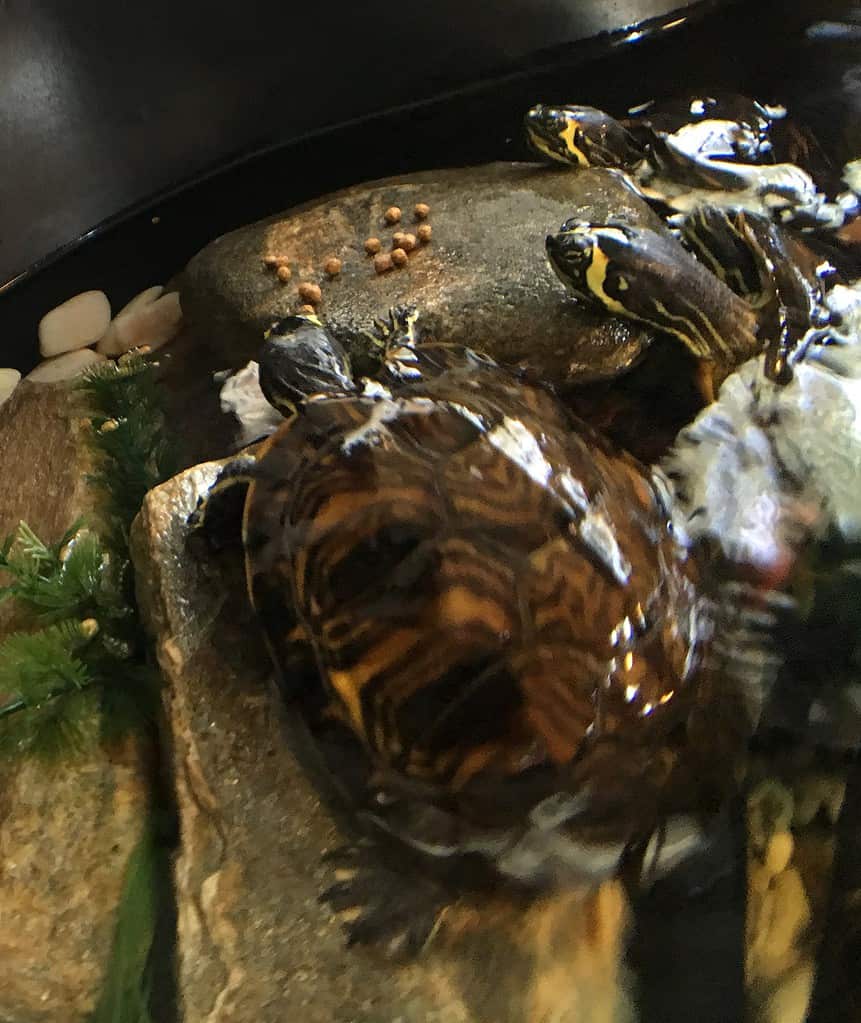
Make sure any rocks in this homemade tank are too big for the turtle to swallow.
While pet stores often have plenty of pieces you can add to your tank, natural supplies are sometimes the best way to go. Using natural wood, rocks, and non-toxic plants from nature saves you money and allows you to create a customized area for your turtle. Some people add local leaves and twigs to create variation in their terrain.
4. Add A Floating a Basking Area

Many turtles like to bask in the sun to warm up, which is common in wild and pet turtles.
When turtles want to warm up, their favorite place is somewhere that they can bask in the heat. Most people set up this basking area on land, but using a floating space gives your turtle an excellent range of their aquarium. Using a tank with a floating space also encourages your turtles to exercise and engage physically.
5. Get a Double Starter Aquarium
To start with multiple turtles in a tank, you must create a double-starter aquarium. This aquarium offers a lot of space, making enough room to get more than one pet, or you can start the beginnings of a massive play area.
6. Add Aquatic Plants
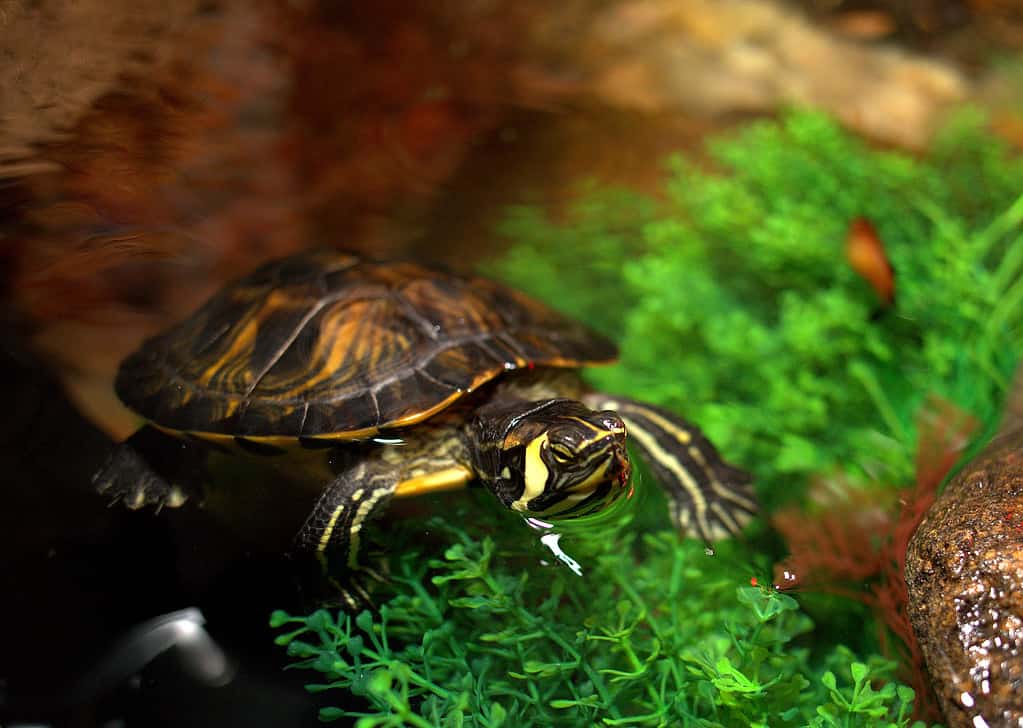
Offering aquatic plants provides beautiful decor and hiding areas for your turtle.
Aquatic plants provide stimulation for the turtle to enjoy safely. Turtles like to have spaces to hide, making the larger plants optimal. If you choose plants they want to nibble on, they are easy to maintain and grow yourself.
7. Create an Underwater Tunnel
If your turtle needs more of a challenge in their aquatic playtime, you can create a tunnel for them to swim through. This DIY project doesn’t require much time, money, or supplies. If you pick up some PVC pipe, cut it into three equal sections. Use a wooden skewer to connect each end of the pipe. Once secured, use magnets to keep it in place.
8. Start With A Small Plastic Bin
When you first adopt your turtle as a baby, they won’t need much space. Furthermore, unless you buy a tank fit for an adult from the start, you must replace it before it gets too much bigger. If this fixture is just a temporary home, using a plastic bin with food-safe materials offers a helpful platform. As long as it has the space to add a heater and an internal filter for the water, the rest of the setup is easy to add.
9. Use Rocks For Variations in Terrain

Using natural wood and rocks creates a balanced atmosphere like their wild habitat.
©iStock.com/:Marina Vedernikova
Turtles need ample space for swimming and walking, and the terrain you set up can include many artificial surfaces. However, aquarium-safe rocks are the easiest to add if you want a more natural landscape. You can even source rocks from outside if you thoroughly wash them before adding them to the habitat. Rocks are also much easier to clean with a simple water hose.
10. Design Your Own Terrain With Painted Styrofoam
Styrofoam offers the unique ability to shape and mold the terrain to suit your turtle the best. Instead of covering the surface with rocks or green plants, use your painting skills to design the terrain’s surface. Use a rule to measure the Styrofoam piece precisely to your aquarium.
Whenever you use any artificial material, you must ensure that all the products are non-toxic. To attach the pieces, you can use sticks to create sturdiness. Then, use a silicone sealant to create a barrier between the Styrofoam and turtles so they do not chew through it. To add more realism, complement your painted terrain with natural rock.
11. Use A Fish Tank Instead
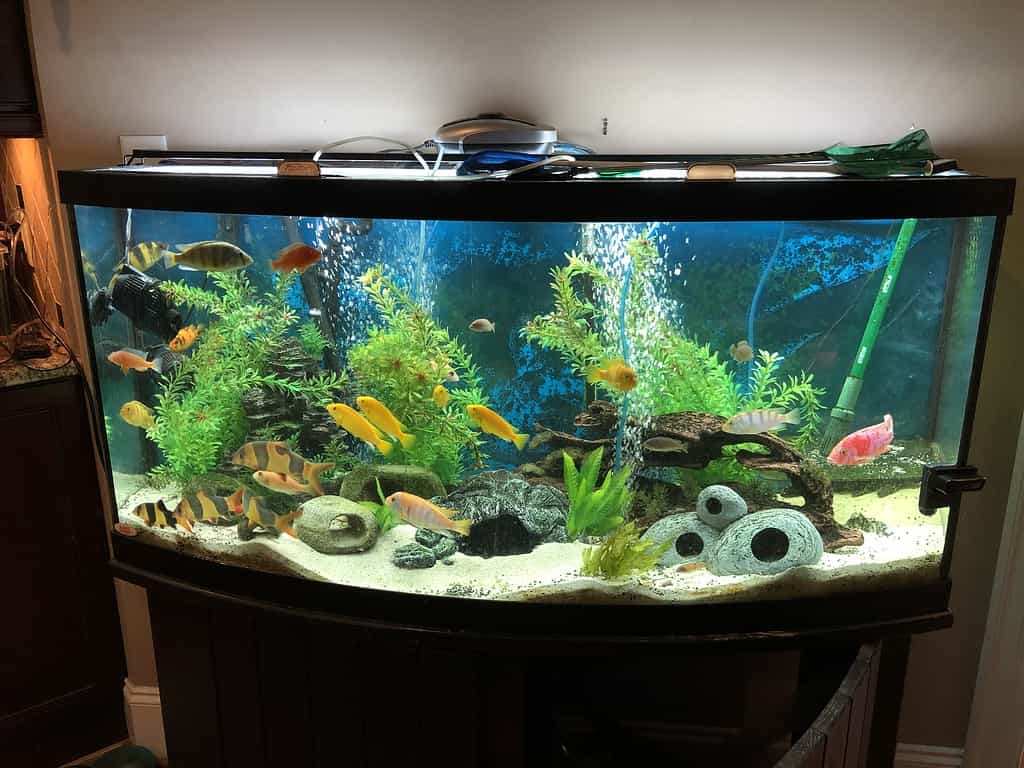
A big fish tank like this one is the perfect size and depth to develop an underwater turtle oasis.
©LizWinfreyV, CC BY-SA 4.0, via Wikimedia Commons – Original / License
Purchasing a full terrarium is expensive, but using a fish tank significantly cuts the cost. It serves almost the same purpose, and many kits come with a water filter, non-toxic plastic plants, and stones. The only thing you will need to provide is terrain to get a break from swimming, but you can set up the terrain above the water to give more depth to the water.
12. Create A Tiny Home Within The Turtle Tank
Using a fish tank means you inherently have less space, which is why it is ideal for small turtles. Setting up a “tiny home” for the turtle takes a little skill around a drill, using driftwood to develop a house-like home for your turtle with any layout you want.
13. Use Foam As The Basis Of Their Basking Area
Styroroam is highly useful to anyone who wants to create custom pieces in their turtle tank. To develop a basking area, decorate your pieces with acrylic paint. If you’re going to make a 3-dimensional structure, add foam pieces with or without paint. Then, use a glue gun to attach it to the back of the tank. Inside, keep the same gravel and substrate that you already added.
14. Create Background Art From Styrofoam
The possibilities are endless once you introduce Styrofoam and silicone sealant to your supply list. If you don’t want to build a whole terrain or basking area that has to support the weight of your turtle, make them a tiny mural. Pick a sheet of Styrofoam that fits your tank, using only acrylic paint to design an image that brings your turtle joy.
15. Get A Plastic Tub With Low Sections
While any plastic tub offers a blank slate to decorate for your turtle, plastic containers with sections already raised within them create the terrain changes you want. If you can’t find a container with these separations, consider setting up a separate train at the bottom.
16. Add Non-Toxic Plants To Grow From Your Aquarium

Growing plants within your turtle tank offers more oxygen and creates a hiding space for your turtle.
©muaiyayo/Shutterstock.com
One of the most significant advantages of using natural plants is their growth. If you set up your turtle tank with space for this growth, the constant water and nutrients ensure the plant continues growing. If it surpasses the surface, cut it down or let it keep flourishing (as long as your turtle still has clear space to swim).
17. Create A Theme In The Tank
These options work great with a theme in mind, like a buried treasure. Look for turtle-safe toys and structures at your local pet store that create bubbles to attract their attention while swimming. Complement the treasure with a sunken pirate ship for underwater places to explore and hide.
18. Set Up A Recreational Area With PVC Pipe
If you want to develop multiple challenges in their terrain, PVC pipe has many uses. Some consumers want to use the pipe for an underwater tunnel, but wide recycled PVC pipe offers the perfect material for a shelter or to create different shapes. Disguise it with brown and green paint to fit within a more natural setting, or use bright colors to create a distinct contrast.
19. Use Wood Instead Of Classic Substrate
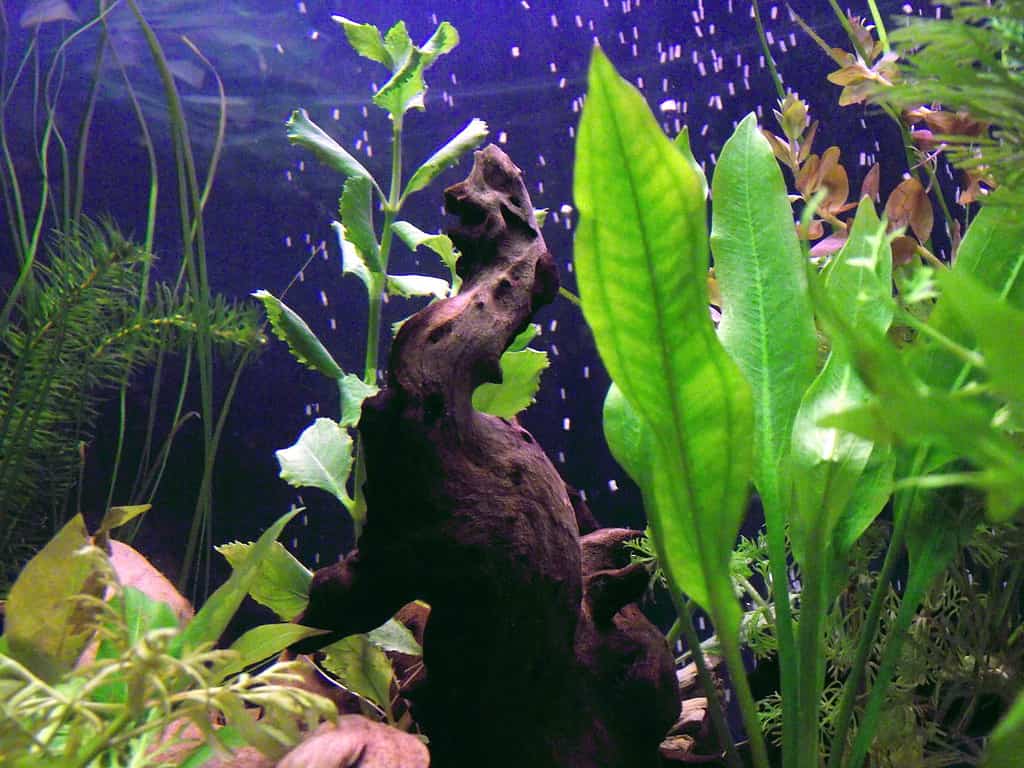
Mopani wood offers the proper density to stay in place in your homemade turtle tank.
Many people use gravel or pebbles in aquatic tanks, but the risk of choking is substantial. Removing it requires surgery, but lining the bottom of a turtle tank with log-shaped heavy pieces won’t put them at risk of choking. Stick with Mopani wood rather than using cork bark that changes water’s color. It doesn’t grow mold with moisture exposure and has the density to stay at the bottom of the tank.
20. Add Fake Grass to Your Turtle Tank
If you want to set up a beautiful space for a box turtle, using fake grass for the terrain is gentle on their feet and provides extra comfort for your turtle. The artificial grass can be cut to fit your specific aquarium, gluing it to the surface it needs to stay on.
21. Create A Jungle Seascape For Your Turtle
If you have a bit of time and a lot of creativity, you can turn your turtle’s tank into a jungle oasis. The setup requires many plants, making turtles feel more secure with plentiful spaces to hide. It would be best if you still had a pond, but it is as embellished as you want to make it. Make sure to secure any permanent fixtures in place to maintain stability.
22. Build An Outdoor Pond
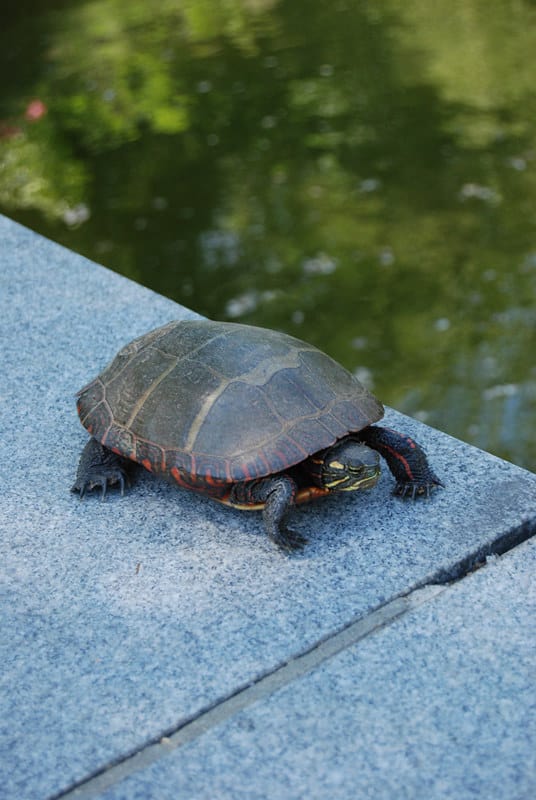
Creating an outdoor space is one of the most natural ways to house your turtles in a homemade area.
If you want to break away from the idea of a classic turtle tank and have a lot of space, consider installing an outdoor turtle pond if your local environment is safe for your pet. They still require indoor space, so this outdoor pond is a secondary home. This pond still needs to have some terrain above water for resting and feeding the turtles, but it also gives your pet a substantial space for swimming. Painted turtles appreciate this extra space the most, but it gives you more space to create.
23. Buy A Pre-Formed Pond
While 5there are plenty of plastic bins already with low sections for organization, check out an outdoor supply store for a plastic pond. Plastic ponds have multiple levels, offering the perfect space for any semi-aquatic turtle. They can be set up the same way as the plastic storage bins, except that you won’t have to create the shape; the pond design does it for you. You will need to purchase aquarium sealant to secure any decorative features.
24. Avoid Any Fixtures With Sharp Edges
Sharp edges are the enemy of any turtle tank. Look for toys, substrates, and even food dishes with rounded corners and edges to avoid injury to your pet.
25. Keep It Simple
Keep it simple if you aren’t sure what to put in the tank. Your turtle needs regular access to food, water, shelter, and warmth. If you have these simple factors covered, provide one or two simple toys that encourage them to move around. If they have somewhere to hide when they want to be out of view, your turtle will be happy to have your company.
What to Keep Out Of Your Turtle Tank

Avoid including toxic plants, like duckweed, in your turtle tank.
©iStock.com/Piyavachara Arunotai
As you create this new habitat for your turtles, remember to be cautious when adding plant life to the tank. Any plant life you put in the tank needs to be either non-toxic imitation plants or a species of plant that isn’t dangerous to a turtle. Turtles attempt to eat any of the live plants in their tanks, so you must avoid duckweed, water lilies, and water hyacinths. All three of these plants are dangerous to turtles.
Avoid using tap water for their water supply. According to the Environmental Protection Agency, water treatment plants can legally use chemicals like chlorine and chloramine to eliminate contaminants. While the levels are low enough that the general population can handle some consumptions and cleaning with this water, turtles cannot control the concentration. Instead, they use filtered water for drinking and non-chlorinated water for swimming.
If you add rocks, avoid the kind made for aquariums for fish. These small rocks make it easy for turtles to mistake them for food. If they swallow rocks, they can choke and obstruct their breathing. Use rocks that are at least half the size of a turtle to avoid the risk of choking.
Homemade Turtle Tank Ideas You Will Love
| No. | Turkle Tank Idea |
| 1 | Purchase a double-starter aquarium for extra space. |
| 2 | Use a 30-gallon plastic bin to house your turtle. |
| 3 | Pick out local wood and rocks from nature to build an earthier habitat. |
| 4 | Add a basking area that floats to motivate exercise. |
| 5 | Use a plastic bin for the main enclosure rather than a traditional glass tank. |
| 6 | Add aquatic plants that are not toxic to your turtle. |
| 7 | Build a tiny house inside your turtle tank. |
| 8 | Use a plastic bin for the main enclosure, rather than a traditional glass tank. |
| 9 | Change up the terrain by using clean rocks from outside. |
| 10 | Paint Styrofoam and cover it with silicone sealant for customized terrain. |
| 11 | Buy a fish tank kit and create a deeper aquatic space. |
| 12 | Build a small house inside your turtle tank. |
| 13 | Create a Styrofoam platform for your turtle to bask. |
| 14 | Decorate a backdrop with Styrofoam and acrylic paint. |
| 15 | Use a plastic tub with pre-made organization. |
| 16 | Grow plants from the turtle tank. |
| 17 | Inspire yourself by choosing a classic underwater theme like a shipwreck. |
| 18 | Use recycled PVC pipe to develop colorful habitats with wider cylinders. |
| 19 | Instead of substrate, use Mopani wood to line the bottom of the aquatic area of the tank. |
| 20 | Use fake grass to replicate natural outdoor areas. |
| 21 | Create a jungle-themed tank with plentiful plants. |
| 22 | Create a secondary space outside when the weather is nice. |
| 23 | Purchase a pre-formed pond as a plastic turtle tank with multiple levels. |
| 24 | Protect your turtle from sharp corners and edges. |
| 25 | Prevent complications and overwhelming design ideas by keeping the setup simple. |
The photo featured at the top of this post is © Elina Leonova/Shutterstock.com
Thank you for reading! Have some feedback for us? Contact the AZ Animals editorial team.







